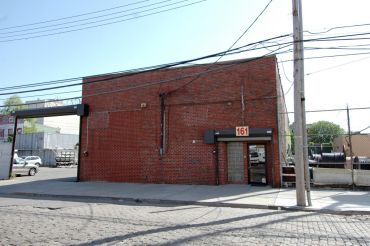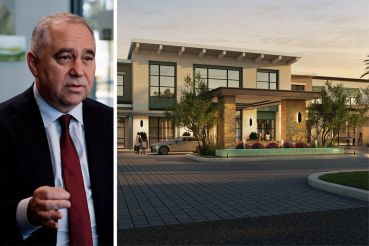Despite Shutdown, Brightline Still Drives South Florida’s ‘Rail Estate’ Market
By Mike Seemuth June 2, 2021 2:48 pm
reprints
A pandemic-driven suspension of the Brightline train service has endured for more than a year, yet it hasn’t derailed real estate investment near its South Florida stations.
Brightline, which launched its passenger rail service in 2018, currently connects Miami to Fort Lauderdale and West Palm Beach, at downtown train stations in each city. Service, which was suspended in March 2020 upon the onset of the COVID-19 pandemic, has yet to resume.
New York-based Fortress Investment Group, which owns Brightline via its Florida East Coast Industries (FECI) unit, has pursued a strategy of mixing its infrastructure play with large-scale, real estate investments. Coral Gables-based FECI has developed multifamily and office buildings near Brightline stations and sold most of these projects to institutional investors at nine-figure prices. It also has a sizable portfolio of land and real estate holdings along the train line, though some industry players see FECI beginning to take a step back from these assets.
“I think Brightline was a real estate play. I think it always has been,” said Bradley Arendt, director of urban core markets in South Florida for brokerage firm Colliers.
One of the biggest trades in Miami this year — Blackstone Group’s purchase of 2 and 3 MiamiCentral for $230 million — had a Brightline storyline. FECI developed the pair of office buildings, located near its Brightline outpost in MiamiCentral station, and sold them in May 2019 to Shorenstein Properties for $159 million. After holding the office buildings for 22 months, Shorenstein flipped them for a tidy profit in March to Blackstone.
The Brightline connection at MiamiCentral was also a major draw for Miami Worldcenter Associates (MWA), which is developing the 27-acre Miami Worldcenter, a massive, mixed-use project that sprawls across three city blocks. The project is flanked on the west by the Brightline station and on the east by AmericanAirlines Arena, home of the NBA’s Miami Heat.
“My same pitch to anyone is the same pitch that, I’m sure, someone at Shorenstein made to Blackstone, or Blackstone made internally,” said developer Nitin Motwani, managing principal of MWA. “You’re at the highest elevation downtown. You’re next to the train station. You’re surrounded by all the arts, culture and entertainment … It’s a great location.”
The train station is “essentially an extension of Miami Worldcenter,” he said.
Fading ambitions
In another example of FECI’s real estate plays, New York Life paid FECI $114 million in late 2020 for ParkLine Palm Beaches, a 24-story, 290-unit apartment building next to the Brightline station in Downtown West Palm Beach. FECI still owns sister property, ParkLine Miami, a two-tower, 816-unit rental apartment complex that the company built as a residential component of its MiamiCentral train station.
But Arendt said the focus on real estate development appears to have faded at FECI.
It hired Cushman & Wakefield to market several prime properties near its Brightline stations, including 2.7 acres in Downtown Miami and a 0.9-acre site in Downtown Fort Lauderdale. Signs posted on the Miami property advertise it as “two supertower sites” with mixed-use zoning.
“I thought they might develop them one day themselves,” Arendt said. “If they’re not going to develop them in the next five years, this is as good a time as any to put them on the market and see if they can extract some equity.”
FECI also listed property near the Brightline station in West Palm Beach, said Greg West, CEO of Orlando-based ZOM Living. “That indicates to me that they are certainly not intending to develop it, but rather to sell their development opportunities around their stations,” he said.
Exactly why FECI is stepping back from development in the Brightline corridor is unclear.
“Perhaps this is an opportune time to sell off some of these investments and create some liquidity,” said Jaime Sturgis, CEO of Native Realty in Fort Lauderdale. “Closing for COVID has been painful, I’m sure. There’s a lot of fixed overhead that goes into an operation as large as what they’ve done.”
FECI also has an active development pipeline, with the firm sketching out Brightline West, an ambitious, high-speed rail project that will connect Los Angeles to Las Vegas. It also has three more stations in the works along the South Florida route — in Aventura, Boca Raton and PortMiami — and is building a second phase that will extend service to Orlando.
“FECI and Brightline have built commercial real estate platforms in south Florida that have created enormous value in both the industrial and transit oriented development markets,” Ben Porritt, senior vice president of government affairs at Brightline, said in a statement to Commercial Observer. “We have significant portfolios in both arenas and continue to optimize the realization of the value we possess from both asset based through our very active ongoing businesses.”
Rail estate
Investors large and small are likely to keep shopping for properties and pursuing projects near the Brightline stations.
Kushner Companies, for example, plans to pay $49 million for a 4.2-acre site just south of the Brightline station in Fort Lauderdale. The proximity of the station was “paramount” among the reasons Kushner put the site under contract, said Laurent Morali, president of the New York City-based developer. Kushner won city approval May 18 for a mixed-use development there with about 1,300 apartments, office and retail space, and possibly a hotel.
One block west of the Fort Lauderdale station, Richard Mercede and his family own a two-story commercial building at 199 NW 5 Avenue. They also own the rest of the block, about an acre, and have listed it for sale for $12.5 million. Mercede said he has done preliminary work toward city approval for a 400-unit multifamily development on the transit-oriented site.
“That train, that’s the engine,”Mercede said. “It’s going to be a game-changer.”
A zoning change in Fort Lauderdale has increased the allowable density of developments near the Brightline station, Sturgis said. “The west side of the tracks, which is where their station is located, has not been as successful [as the east side] from a redevelopment standpoint,” he said. “So, I think the up-zoning will spur additional mixed-use development in that area.”
In Downtown West Palm Beach, ZOM Living is building Watermark, an eight-story, 154-unit residence for retirees one block from the Brightline station. Drawn by the proximity of the station and other downtown attractions, ZOM acquired the development site last summer in a closing that was delayed, but not canceled, by COVID, West said.
In Miami, Motwani said that Miami Worldcenter has been moving full steam ahead. The project’s master plan calls for 1,875 residential units, 2,050 hotel rooms, and half a million square feet of exposition space, retail space spanning 300,000 square feet, and as much as 300,000 square feet of office space.
About $1.2 billion of projects in the phased, $4 billion Miami Worldcenter development have been completed, he said. Among the high-rise finished products are Caoba, a 44-story apartment building with 444 units, and Paramount Miami Worldcenter, a 569-unit, 60-story condominium overlooking Biscayne Bay.
“In 2020, we topped off three buildings and started a new one,” Motwani said. Last year, the development team also “sold over $100 million of land to various developers who have discussed starting construction this year.” Among other projects headed for a 2021 groundbreaking, construction could start this year on Legacy Hotel and Residences, a 39-story, mixed-use building with 255 hotel rooms and 278 condo units.
A muted MiamiCentral
These days, MiamiCentral station is one of the quietest places in Downtown Miami. With no train service, people get in line not to buy a ride, but to dine inside of a Chick-fil-A restaurant on the ground floor of the station.
FECI has leased 87,000 square feet of retail space at MiamiCentral and has 50,000 square feet of inventory, said Zach Winkler, an executive vice president at brokerage firm JLL, which is marketing the space. The firm has not adjusted asking rates for leased space at MiamiCentral, despite the temporary shutdown of train service.
Most tenants with signed leases will occupy space at MiamiCentral after Brightline resumes rail service, probably in the fourth quarter of 2021, Winkler said.
“It is no secret that the trains not running definitely hurt from a leasing standpoint,” he said. “But we’re seeing a lot of good forward momentum and a lot of optimism about everything once the trains start running again.”
Winkler cited the transit-intensive quality of the MiamiCentral’s location near stations for other transit services: Metromover (for short trips around Downtown Miami) and Metrorail (for longer trips to suburban stops south of the central business district).
“It’s really a connection point to all of South Florida,” Winkler said. “To a certain degree, it’s comparable to the connectivity of Grand Central or Penn Station, in terms of how it connects regional trains and local trains.”
Transit-oriented development is spreading south of Downtown Miami, too.
The Miami-Dade County government has issued requests for mixed-use development proposals next to several stations on its Metrorail line, including stops in Coconut Grove, Coral Gables and South Miami, said Javier Aviňó, a partner at law firm Bilzin Sumberg, who leads its land development and government relations practice group.
In the Miami area, “Metromover and Metrorail are integrated into FECI and Brightline,” said Aviňó, “so when you talk about one, you kind of have to talk about them all holistically, because it becomes a network.”
Brightline has also continued to work toward putting new stations between the three existing ones in South Florida and extending its passenger train service to the Orlando area, including a stop near Walt Disney World.
“The big tie-in is really Orlando,” Motwani said. “You’ve got 60 million people [per year] visiting there.”


